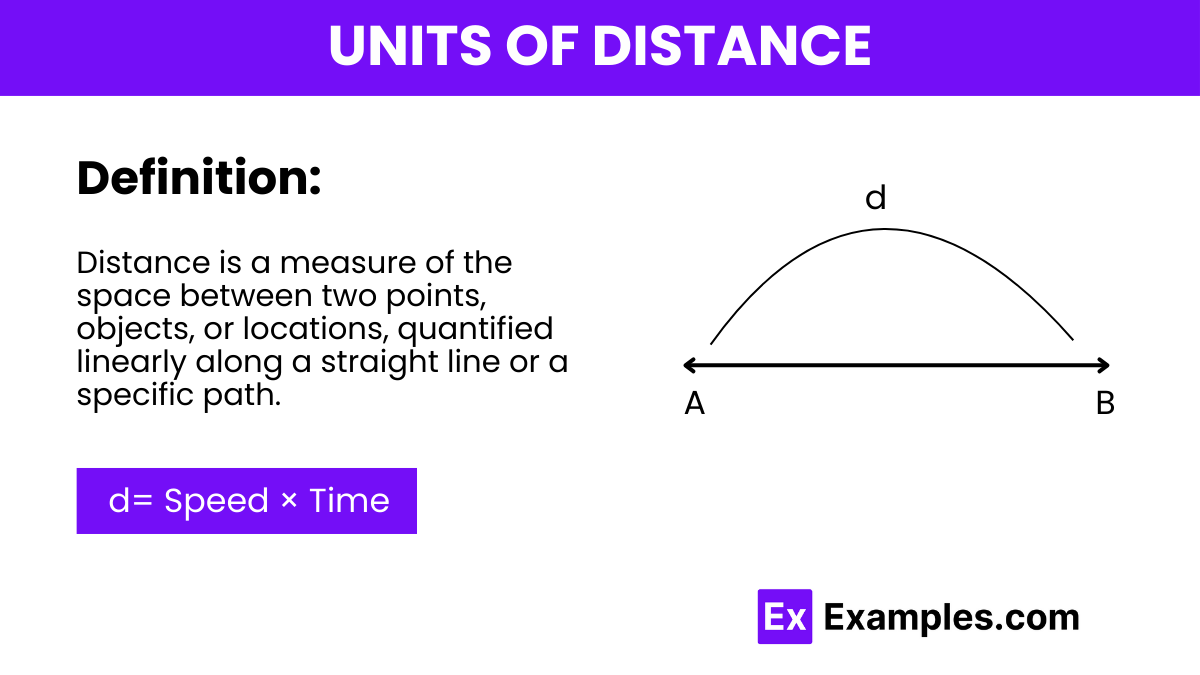Which of the following units is smallest?
sample
sapl
sample
sample

A simple formula to calculate distance when speed and time are known is:
d = distance
S=speed
T = time
Distance is measured using units that represent length, with the most common being meters (m), the base unit in the International System of Units (SI). For longer distances, kilometers (km) are used, particularly in navigation and geography, while miles (mi) are preferred in the United States and the United Kingdom for road distances. Feet (ft) and inches (in) are also widely used, particularly in the United States, for smaller-scale measurements in various applications, including construction and manufacturing. Each unit serves to ensure precise communication and computation of spatial relationships in different contexts.
| Unit | Symbol |
|---|---|
| Meter (m) | m |
| Kilometer (km) | km |
| Centimeter (cm) | cm |
| Millimeter (mm) | mm |
| Foot (ft) | ft |
| Inch (in) | in |
| Mile (mi) | mi |
| Yard (yd) | yd |
Meter (m): The basic unit of distance in the International System of Units (SI), equal to the distance traveled by light in a vacuum during a time interval of 1/299,792,458 of a second.
Kilometer (km): Equal to 1,000 meters, commonly used for longer distances such as road distances and geographical measurements.
Centimeter (cm): Equal to 0.01 meters, often used for shorter distances such as the length of small objects or in scientific measurements.
Millimeter (mm): Equal to 0.001 meters, commonly used for very small measurements such as the thickness of paper or precision engineering.
Foot (ft): Equal to 0.3048 meters, commonly used in the United States and other countries for everyday measurements of height and distance.
Inch (in): Equal to 0.0254 meters, commonly used for smaller measurements such as the length of small objects or in construction.
Mile (mi): Equal to 1,609.34 meters, commonly used in the United States and some other countries for longer distances such as road distances and geographical measurements.
Yard (yd): Equal to 0.9144 meters, commonly used in the United States and some other countries for shorter distances, especially in sports and construction.

| From Unit | To Unit | Conversion Formula |
|---|---|---|
| Kilometer (km) | Meter (m) | 1 km = 1000 m |
| Meter (m) | Kilometer (km) | 1 m = 0.001 km |
| Meter (m) | Centimeter (cm) | 1 m = 100 cm |
| Centimeter (cm) | Meter (m) | 1 cm = 0.01 m |
| Meter (m) | Millimeter (mm) | 1 m = 1000 mm |
| Millimeter (mm) | Meter (m) | 1 mm = 0.001 m |
| Foot (ft) | Meter (m) | 1 ft = 0.3048 m |
To convert kilometers to meters, multiply the number of kilometers by 1000. For example, 1 kilometer is equal to 1000 meters.
To convert meters to kilometers, divide the number of meters by 1000. For instance, 1000 meters is equivalent to 1 kilometer.
Converting meters to centimeters involves multiplying the number of meters by 100. Thus, 1 meter equals 100 centimeters.
To convert centimeters to meters, divide the number of centimeters by 100. Therefore, 100 centimeters is equal to 1 meter.
When converting meters to millimeters, multiply the number of meters by 1000. For instance, 1 meter is equivalent to 1000 millimeters.
To convert millimeters to meters, divide the number of millimeters by 1000. Hence, 1000 millimeters is equal to 1 meter.
Converting feet to meters involves multiplying the number of feet by 0.3048. Therefore, 1 foot is approximately equal to 0.3048 meters.
The largest distance units include kilometer (km), mile (mi), and astronomical units (AU). These units are commonly used for vast distances such as between cities or celestial bodies.
The shortest measurable distance is currently estimated to be the Planck length, approximately 1.616 x 10^-35 meters, according to quantum mechanics and theoretical physics.
Text prompt
Add Tone
10 Examples of Public speaking
20 Examples of Gas lighting
Which of the following units is smallest?
sample
sapl
sample
sample
How many inches are in a foot?
10
12
14
16
How many feet are in a yard?
2
3
5
6
What is the metric equivalent of a mile?
1.6 kilometers
1.6 meters
1.6 centimeters
1.6 millimeters
Which unit is used to measure astronomical distances?
Kilometer
Mile
Light-year
Meter
Which of the following is a unit of length in the metric system?
Inch
Foot
Meter
Yard
40
100
90
78
Which unit is used to measure very small distances, like the size of bacteria?
Kilometer
Centimeter
Millimeter
Micrometer
What is the SI unit for measuring distance?
Kilometer
Meter
Mile
Foot
Which of the following is the longest distance?
1 kilometer
1 mile
1 meter
1 yard
Before you leave, take our quick quiz to enhance your learning!

